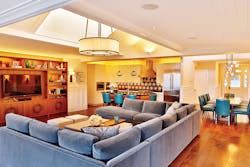When I first heard the term “human-centric lighting” many years ago, the first reaction from my marketing brain was “Compared to what?” I immediately understood that human-centric design was against lighting that seemed to be in conflict with basic human nature (which then included, and still does, much of the installed lighting in the built environment). But human-centric lighting was confusing because it violated one of the tried-and-true laws of branding — positioning. “Re-positioning” the competition is a classic and very effective positioning tactic, but what was the competition exactly? What was non-human-centric lighting exactly? It turns out that human-centric lighting has a rather longer and more elaborate history than I can go into here. Some of it will be explicated in the Strategies in Light session covering this topic on Aug. 24 at 1:30 PM, featuring Robert Soler of BIOS Lighting and Dr. Kevin Houser of Oregon State University, and moderated by design consultant Nancy Clanton of Clanton and Associates. For better or worse, human-centric lighting caught on and we’re stuck with it until we embrace a better term.
Fortunately, there is one available. Dr. Houser in particular has written quite eloquently on the evolution of the term human-centric lighting, in Leukos and Lighting Research and Technology for the Society of Light and Lighting, as well as a piece in Frontiers in Neurology. He argues for “integrative lighting” as a more appropriate term for what we need to visualize and achieve when working with light in the built environment. I tend to agree, as most parts of a building that are now typically addressed by disparate disciplines need to be integrated, with a more holistic approach to design. And speaker Robert Soler weighs in on human-centric lighting with a freshly published paper on “biologically relevant” lighting in Frontiers in Neuroscience. So many are beginning to see a way forward with a more concrete approach using actionable design concepts.
I put this session together to address a number of issues with human-centric lighting. For as long as it has been discussed, manufacturers and specifiers have been reluctant to wholeheartedly embrace the health claims that began proliferating. Standards organizations have only recently begun to address the issue but are generally not in agreement on all points. Lighting professionals are trained largely as engineers and designers, not as neurobiologists. Despite this disadvantage, they have generally proven to be relentlessly curious and eager to learn about the inner workings of the eye and brain. But a recent research project I undertook for a manufacturer, in conjunction with leading specifiers, indicated a general trepidation about the liability of impacting health and productivity. One of my subjects even said, “…We’re not doctors — we don’t want to take the risk...” Cost and complexity issues are pervasive — although there is much interest in and agreement that circadian lighting is desirable, few firms are specifying and installing it. There are technical issues with controls and determining appropriate light levels and CCT.
There’s also a general credibility problem. The term “snake oil” often comes up in discussions about human-centric lighting, and the latest phrase I like is “health-washing.” One could ask what the harm is in believing in a “sleepy baby” light, as long as it’s not hurting anyone. Having said that, we know that there are problems with much of the lighting we’re exposed to daily in the built environment.
Integrative lighting makes the case for design, rather than technology alone, as the necessary factor in making better buildings. As Nancy Clanton said in our conversation earlier this week, “Electric light can’t do it all.” As much as manufacturers may promote their ability to perfectly replicate sunlight, the lighting community is looking for love in the wrong places if we seek simple technical solutions to bear the load of complex design problems. Integrative lighting takes into account the rich history of architectural solutions to light in buildings that evolved over thousands of years of building practice. Before the advent of gas and electric lighting, windows used to be called “lights.” Yet 20th-century Modernism largely obliterated the understanding of the building’s role as a strategy for mitigating and harnessing light. This history can be leveraged alongside our contemporary lighting and controls technology and our continually evolving understanding of how all organisms interact with light.
In 2013 at the IALD conference in Montreal, I presented a brief talk titled “Building as Luminaire,” in which I encouraged lighting designers to take their rightful place at the table as owners of all light in the building design process. I then proceeded to expand on this idea in later presentations, examining the notion of what buildings might look like if light was the primary consideration in creating an optimal building envelope. At the time I thought it might be received as a crazy notion, but then I started examining older buildings, finding many examples of highly evolved strategies for tapping daylight. Indeed, it seemed as though light was a major factor in shaping architectural form. I even found a modern example of a completely light-centric building in UK architect Michael Pawlyn’s Biomimetic office.
Register now to join us for Strategies in Light, which will be held online from Aug. 24–25, 2021, to learn about integrative lighting and more.
CLIFTON STANLEY LEMON is CEO, Clifton Lemon Associates, and Strategies in Light co-chair.
For up-to-the-minute LED and SSL updates, why not follow us on Twitter? You’ll find curated content and commentary, as well as information on industry events, webcasts, and surveys on our LinkedIn Company Page and our Facebook page.






